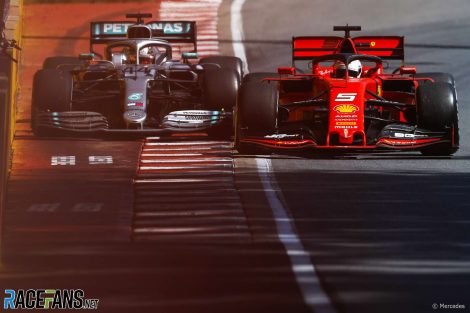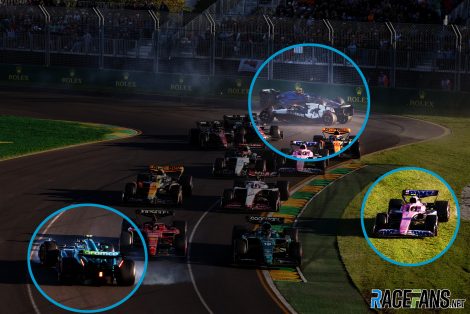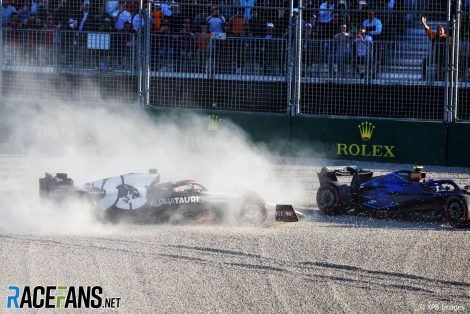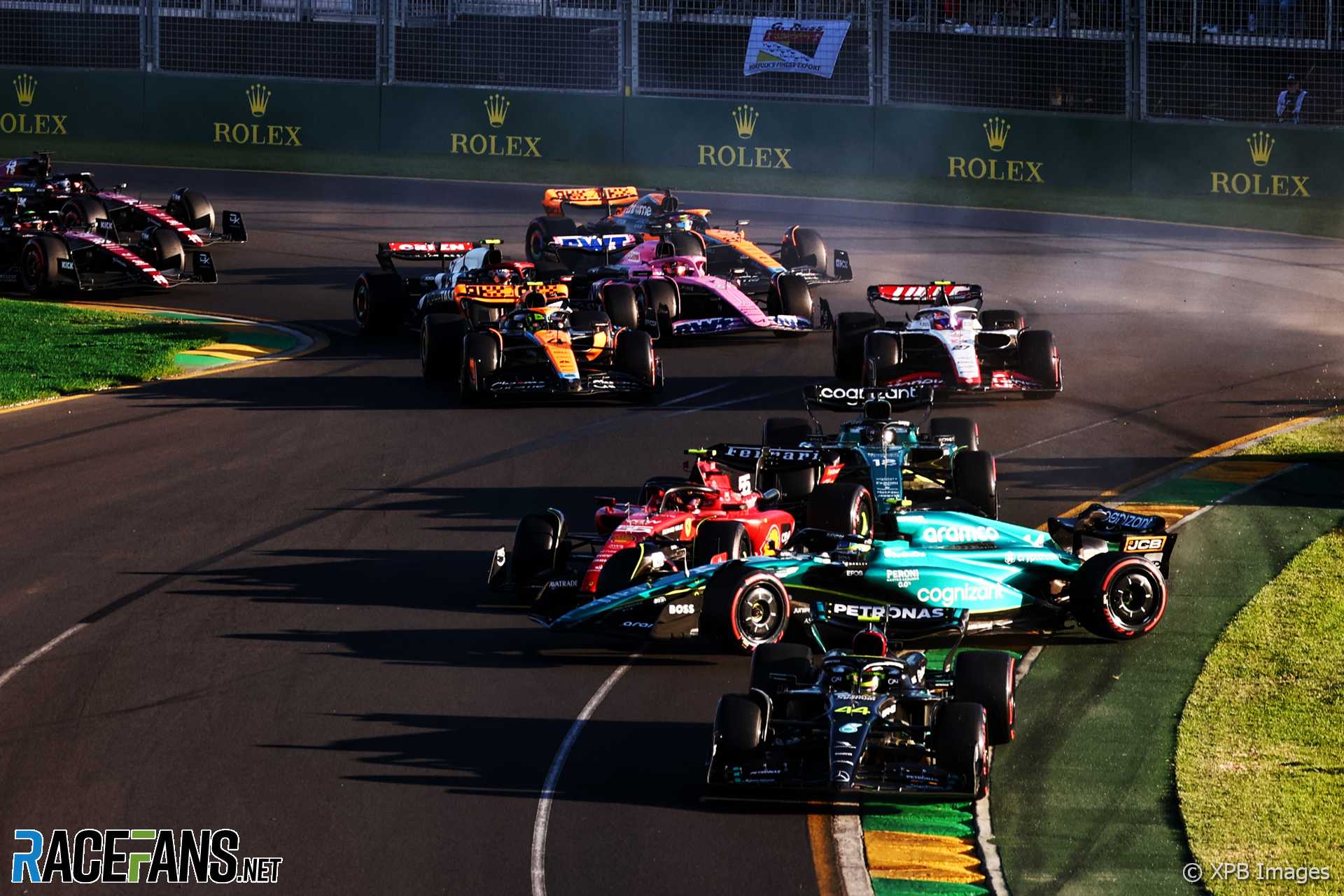Ferrari have confirmed they will ask the stewards of the Australian Grand Prix to reconsider and, they hope, overturn the penalty which cost Carlos Sainz Jnr fourth place in the race.
The FIA learned on Thursday last week the team has applied for a review of the penalty Sainz received for his collision with Fernando Alonso after the standing restart on lap 57 of the race.Ferrari is taking advantage of the same ‘right of review’ procedure which Alonso’s team used to cancel a penalty he had been given in the previous round. But that was one of few occasions in recent history in which a team has successfully used the right of review to reverse a decision by the stewards.
As Ferrari knows, persuading the stewards to overturn a penalty decision is not easy. They tried to cancel the five-second time penalty which cost Sebastian Vettel victory in the 2019 Canadian Grand Prix, They tried to cancel“but failed. The year before Williams also tried to provoke a review of incidents which occured during the Azerbaijan Grand Prix, to no avail.

The examples of successful cases are far fewer. In addition to Aston Martin, Red Bull won a hearing which led to Lewis Hamilton being penalised at the 2020 Austrian Grand Prix. Haas also won a right of review following the United States Grand Prix last year, though it was subsequently overturned following an appeal by rivals Alpine.
On sheer weight of numbers, Ferrari’s chances don’t look good. But do the substance of the cases give the team and its supporters grounds to be optimistic that Sainz may get his fourth place back?
Advert | Become a RaceFans supporter and
Ferrari must convince the stewards of two points in order to win their case. First, they must show there is a significant and relevant new piece of evidence which the stewards should consider. Second, that evidence must convince the stewards to overturn the penalty.

Ferrari also provided a video analysis of the incident in question by former F1 driver-turned Sky television presenter Karun Chandhok. The stewards rejected this as “not significant and relevant as this is a personal opinion by a third party.” Hamilton, who gained the win due to Vettel’s penalty, later admitted he became “relaxed” about the threat to his victory after he learned Ferrari’s case rested in part on Chandhok’s analysis of it. They surely will not make the same mistake again.
New footage of an incident may provide valuable new insight. In 2020 Red Bull used a 360-degree video from Hamilton’s car which was not available to the stewards when they cleared him of failing to slow under yellow flags to prove he deserved a penalty. However discovering new video alone is no guarantee of success, as Mercedes discovered when they requested a review of a decision not to penalise Verstappen in the 2021 Brazilian Grand Prix.

It remains to be seen what new, relevant and significant evidence Ferrari may have discovered which they believe will prompt the stewards to rethink Sainz’s penalty. It is hard to imagine what aspect of the collision was missed in the many replays of the contact seen at the time.
Ferrari were especially frustrated the stewards did not give them an opportunity to put forward their version of events before penalising Sainz. The driver was distraught at his penalty, pleading with his team to speak with them. Vasseur echoed this grievance afterwards. “The biggest frustration was – and you heard it on the radio – to not have hearings,” he said.
Advert | Become a RaceFans supporter and
The FIA handed Sainz’s penalty down at 6:52pm, while the race was still under red flag and awaiting the final restart. A decision on another collision which happened at almost the same time, involving Alpine drivers Pierre Gasly and Esteban Ocon, took over three-and-a-half hours longer to appear. “In this case, I think it would have made sense considering that the race was over, it was not affecting the podium, to have the hearing as Gasly and Ocon had,” Vasseur noted.

One unusual aspect of Sainz’s collision with Alonso is it was effectively rendered meaningless by the stewards’ subsequent decision to change the running order of the race. Alonso fell to the back of the field after Sainz knocked him into a barrier, but was restored to third place when the stewards took the hotly-debated decision to revert to the running order from before the restart and their collision. Ferrari may intends to argue that as the foul was cancelled out, the penalty should be too.
But while there are many cases Ferrari may like to make, the need to supply evidence sets a high bar for them to do so. The team is clearly eager to ‘have its day on court’ over the Sainz penalty, and may have good arguments to make if it does, but whether they get that far is another matter entirely.
Become a RaceFans Supporter
RaceFans is run thanks in part to the generous support of its readers. By contributing £1 per month or £12 per year (or the same in whichever currency you use) you can help cover the costs of creating, hosting and developing RaceFans today and in the future.
Become a RaceFans Supporter today and browse the site ad-free. Sign up or find out more via the links below:
Advert | Become a RaceFans supporter and
2023 F1 season
- FIA president cleared of alleged interference in two 2023 races
- First week viewing figures for new Drive to Survive season fall again
- Max who? Drive to Survive season six prefers its favourite faces
- RaceFans’ complete 2023 season review
- The F1 drivers who pulled off the 10 biggest charges through the field in 2023





MacLeod (@macleod)
12th April 2023, 7:55
It’s very simple question: did he gained a advantage by this ‘accident’ if the answer is yes then he gets a penaulty.
This isn’t a first lap thing it’s a restart and he knows if you can gain a position you bag it almost directly as there was only 1 lap left after that. So did the Stewards their job good i have to say in this case yes.
Tone
12th April 2023, 22:27
He gained no advantage when you consider the stewards decided to restart the race with all competitors given back their pre accident starting positions. Also, a restart is treated the same way as a start in that more leniency is given. Penalty was harsh when you consider others got nothing. Punishment to Sainz was over the top. Poor effort from the stewards.
Jere (@jerejj)
12th April 2023, 8:11
More than anything else, I’m still surprised they waited with appealing until the Thursday after rather than doing so on race day as teams would usually do.
Red Andy (@red-andy)
12th April 2023, 8:31
They might not have been “waiting,” but the “significant new evidence” that is required to uphold a review did not emerge until a few days after the race, @jerejj.
Jere (@jerejj)
12th April 2023, 12:13
@red-andy Good point. I hadn’t thought about this possibility.
SteveP
12th April 2023, 8:21
They would be quite right to draw attention to that collision, as well as the Gasly/Ocon car destruction incident.
From which the outcome is a logical application of penalties to Sergeant, Gasly and Ocon as well as maintaining the penalty for Saintz.
That has the benefit of clearing the proverbial sword hanging over Gasly so that he can get on with adding to his collection of driver penalties and aim for a, never to be beaten, record two race bans in one season. The first would be a record of course.
RBAlonso (@rbalonso)
12th April 2023, 9:35
I’ve expressed my opinion on this incident before but I’ll do so again here. I don’t think this should be a penalty as Sainz is being penalised for causing a collision with Alonso. That’s fine, but we normally penalise if there is an impact to the driver who is taken out. Given Alonso didn’t lose a position, I think a 5s penalty is harsh. What makes no sense to me is how Alonso can be simultaneously considered 11th and 3rd at the start of lap 58. If lap 57 is void the penalty should be void to my mind. It’s not like Sainz is the only driver in difficulty here – Max was wide in turn 1, Sainz, Gasly, Perez and Sargeant were way too deep. Hulkenburg, Stroll and Norris were wide in T3. Whilst that doesn’t relieve Sainz of his responsibility, we need to factor in the context that the restart was a shambles and that’s on the race officials themselves. We should never have had a red flag and a restart there – it was always going to end in tears. To add inconsistent application of the rules post that was the cherry on a fairly terrible cake. My honest feeling is that the stewards penalised him thinking they would use the red flag order not the lap 57 grid order for the restart – in that case it would be fair, but doubling down on poor officiating is not doing anyone any favours.
Andy (@andyfromsandy)
12th April 2023, 9:59
Penalties are not awarded on the basis if there is an impact to a driver. That would be taking the consequences into account which the stewards are certainly not supposed to do.
The drivers in reality caused the shambles, They were not driving to the conditions, IMO. Drivers were watching drivers and not braking when required with cold tyres. Gasly was going too fast and Sainz was in the mood to not let him passed so to was going too fast.
The decision for Sainz was the gap to Alonso was sufficient that he should have been in a position to take avoiding action but didn’t.
Sargeant admitted afterwards he didn’t know why he couldn’t stop from hitting de Vries. That is or ought to have been a slam dunk penalty as well.
anon
12th April 2023, 11:16
@andyfromsandy then maybe the question should be why it was only Sainz who was penalised in that instance?
If Gasly was also going into that corner excessively fast and ended up rejoining the track in an unsafe manner and causing a crash, and if you also think that Sargeant should have been penalised for his collision with de Vries, then why weren’t they? If that is the standard to which Sainz is being held, shouldn’t other drivers whom you deem to have also driven in a reckless manner be, at the very least, investigated (the stewards having not even looked at Sargeant colliding with de Vries)?
You might say that the stewards are not supposed to take the consequences into account, but there does seem to be a perception that they sometimes do, whilst others question whether the stewards sometimes “adjust” their decision depending on what impact it might have. For example, some have questioned whether the decision to not penalise Gasly, when other drivers have been penalised for rejoining the track in a similar manner in previous Australian GP’s, was because the stewards didn’t want to be the ones responsible for Gasly earning a one race ban, for example.
Andy (@andyfromsandy)
12th April 2023, 12:54
I have no clue like the rest of us why Gasly and Sargent didn’t get penalised.
On the FIA website is the decision documents for Gasly and Ocon and it reads like they both decided it was a racing incident and pleaded the case for no penalty.
I didn’t see any document on Sargent suggesting they didn’t even bother investigating it.
RBAlonso (@rbalonso)
12th April 2023, 12:25
In my opinion penalties should be awarded based on the impact – otherwise what are we penalising? Surely the penalty is to offset the losses given a team can’t sue another for damage or prize money. We don’t penalise drivers for missing apexs or innocuous collisions. For example Leclerc with Stroll, Charles is at fault and he goes out of the race so no penalty. Had Stroll also went out it should be a grid drop next race.
Not penalising without context of impact ends up with Max in Jeddah and Interlagos in 2021 where he was gaming the system. He knew Lewis wouldn’t turn in on him so it was ‘ok’ to run him off the course at every opportunity. The stewards should have penalised Max multiple times but that doesn’t mean the opposite shouldn’t happen. If you make contact and neither driver loses a place or has damage I don’t think that’s a penalty – I think most of those cases are considered as racing incidents. So if Alonso gets the position back, surely it’s a racing incident?
I just can’t understand any logic that places Alonso 11th and 3rd simultaneously – if you abort a start in any sport the reset must negate the penalty.
David
12th April 2023, 20:06
I like the way you think.
One thing I have learned this year is that logic in F1, and the world in general, is no longer a thing and you’ll drive yourself mental trying to comprehend nonsense.
“They” just want to entertain our tiny brains.
drmouse (@drmouse)
13th April 2023, 11:45
Penalties are awarded based on behaviour*. It shouldn’t matter whether a dangerous move simply ended with nudging a competitor or taking them out: it’s the dangerous move which is penalised, not the consequences.
*The one notable exception is leaving the track, which is only penalised if they gained an advantage… I’m not a big fan of this exception.
slowmo (@slowmo)
12th April 2023, 10:49
I would imagine Gasly and Ocon who lost out as a direct consequence of the accident Sainz caused would disagree with your analysis. Regardless whether the restart was warranted or not, he still went ploughing in like a rookie.
RBAlonso (@rbalonso)
12th April 2023, 11:36
Gasly and Ocon went out because of an unsafe rejoin from Pierre. I think it’s a slippery slope if we start saying cars ahead of an incident are responsible for things that happen behind it. If first place gets oversteer, comes out of the power and the guy behind has to ease up then it’s not a penalty for the driver in first if the driver in fourth hits the driver in third. If Hulk and Norris came together I’d fully back Sainz is at fault and gets a penalty but Pierre didn’t need to rejoin where and when he did and should own that accident @slowmo
anon
12th April 2023, 15:19
@slowmo was Gasly’s crash with Ocon really dependent on Sainz’s actions?
The trajectory and speed that Gasly was taking, given he locked his brakes as he tried to slow down for Turn 1, meant he was always going to end up going across the track. Once that occurs, it then becomes Gasly’s responsibility to return to the track in a safe manner.
Irrespective of whether there was or wasn’t a collision between Sainz and Alonso, Gasly’s actions still fail to meet the requirement to rejoin the track safely given that he chose to move his car further to the right and across the racing line, when he could have stayed closer to the left hand side and reduced the risk of a collision.
Axel
12th April 2023, 10:45
In my opinion this is a slam dunk penalty. It is just a bit harsh because of the way the race finished meaning he lost a large amount of positions and the fact that Alonso didn’t lose anything because of the collision. But if you look at the incident, it’s pretty clear that Sainz was predominantly at fault and thus received a penalty. 5-seconds because it was a lap-1 incident.
The bigger issue is that Sargeant and Gasly both did not receive any penalties. Sargeants collision with De Vries was about as clear of a penalty as you’re gonna get and the fact that he was cleared makes it difficult to explain why Sainz did deserve a penalty.
I think the problem in this case is not that the penalty for Sainz is unjustified, but simply that some other incidents were treated differently.
David
12th April 2023, 20:08
Its obviously not a slam dunk if there is this much debate and Ferrari are trying to challenge it. Maybe like, a mediocre lay-up?
David BR (@david-br)
12th April 2023, 21:45
Can Sainz be given a grid penalty too if Ferrari are found to be wasting everyone’s time?
Hamilton shrugs and accepts the absurdity of Abu Dhabi 2021 without appeal. Sainz is still moaning about losing third place on one podium for an incident we all saw that he caused as the ‘worst decision he’s ever seen.’
Todfod (@todfod)
13th April 2023, 13:42
Agree @david-br . If Hamilton can get past Abu Dhabi 2021 without launching a full blown appeal … then Sainz and Ferrari should really drop their appeal for an incident that deserved a penalty, got the apt punishment, but felt ‘harsh’ later because the race got restarted due to a red flag.
I think this is Vassuer just practicing politics, since he’s had no other impact at Ferrari currently.
David BR (@david-br)
13th April 2023, 14:03
@todfod I think I have less problem with Ferrari supporting their driver than with Sainz feeling so hyperbolically aggrieved… It just seems ridiculous that someone penalized for causing an incident that would have sent Alonso to the back of the grid complain because luckily (for Alonso) the race positions were reset. Just take the penalty and try to do better in the next race. It’s what the top drivers do, a question of attitude. It was the protestation of ‘worst decision ever’ that really riled me. Only if you inhabit the epicentre of the Carlos Sainz universe.
Todfod (@todfod)
13th April 2023, 14:47
I agree man. Just because Alonso got lucky with the race reset doesn’t make Sainz’s mistake any different. He still took out a competitor and got a just penalty. His whining is ridiculous.. And petty. What does he want from this ridiculously daft complaint?? A P4?! (slow clap)
David BR (@david-br)
14th April 2023, 0:04
Maybe it’s to do with the internal competition with Leclerc? Leclerc had a poor weekend, Sainz was going really well until the collision with Alonso. I get his frustration during the race, but surely after it he’s had time to cool down and assess properly.
Todfod (@todfod)
14th April 2023, 7:34
@david-br
I’m pretty sure that’s exactly what it is. Neither are going to fight for the championship.. but there is still a battle for team leader within Ferrari. I mean there’s only going to be 2 or 3 weekends in the entire season where Sainz is going to be quicker, or Leclerc is going to throw away a result. So this was a wasted opportunity for Sainz to get a nice points lead on his teammate and avoid #2 driver calls.
It’s incredible the amount of luck Sainz has against Leclerc in the points tally. One driver has been head and shoulders above the other, but the points total never reflects the gap in class.
Esploratore (@esploratore1)
13th April 2023, 1:38
I still think they need to analyse the situation more before applying penalties, currently the rules say the minimum penalty is 5 sec, in that case introduce another: 1 sec for the most minor offenses, and yes, this is definitely enough of an offense for the 5 sec one, but the circumstances (cars stacked and no overtakes allowed till the end) require a minor penalty here, surely since alonso also got back his place.
Alternatively, there could be 1-2-3 position penalties, in this case sainz would only lose 1, which imo is harsh enough considering alonso got back his place.
drmouse (@drmouse)
13th April 2023, 11:50
I do believe position-based penalties should be available. In fact I’d suggest that, if a penalty cannot be served in the race, a position-based penalty is often more appropriate, as it ensures consequences and stops a driver from being able to pull out a gap and have no effective penalty.
This could be implemented as e.g. a “5 second / 1 position” penalty.